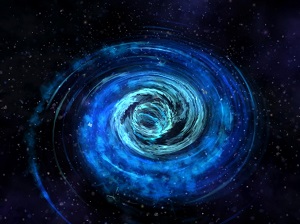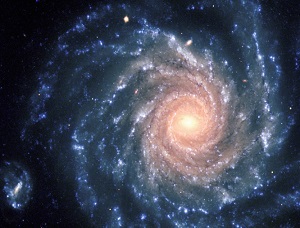The Big Bang and Black Holes
The “Big Bang” was a name given to the concept that the entire universe started as a very small, dense bit called a “singularity” and then expanded rapidly to form our universe.
The first ideas that the universe had expanded came from observations of the redshift as we look out into space. The increasing redshift measurements seemed to be an indication that the universe was expanding. Later, after the 1990’s, further astronomical observations regarding temperatures in space also indicated that the universe used to be very hot and dense and had then expanded out.
In 1949, Sir Fred Hoyle, a British astronomer, was discussing the crazy idea that the universe had expanded in the past. He thought, at that time, that the universe had always been the way it is today. So he mocked the idea of a sudden expansion at the beginning and called it “the Big Bang.” The name stuck.
A little bit, yes. In the Bible, God says twelve times that He stretched out the heavens. So that is certainly an expansion! Astronomical evidence does indicate it happened very fast at first, and this agrees with the Bible’s implications during Creation Week. However the Big Bang says it started with a tiny, super-dense singularity and the Bible tells us God created time, space and matter from nothing. So there is a big difference there. The Big Bang also includes the idea that gravity is responsible for most of what we see in the universe, but gravity works very slowly – it is a weak force. The Bible tells us creation was finished in six days. That couldn’t be gravity! So the Big Bang and the Bible agree that there was a beginning rapid expansion of the universe, but except for that, they disagree about almost everything else.
No. The universe really did expand.
One of the main things scientists do is try to prove or disprove their ideas. They look at the facts and the measurements and everything they can find to discover whether or not what they are thinking is true or if they have to change what they are thinking. There is a major problem with the Big Bang theory regarding gravity. Gravity is a weak force and cannot hold galaxies together as the galaxies spin around their centers. So scientists have decided there must be a lot of matter we cannot see to provide the gravitational force which would hold galaxies together. They call this “dark matter.” No one has ever seen dark matter. No one has ever measured dark matter. No one has ever found dark matter at all. But in order to support the idea that gravity is holding galaxies together, they had to invent something to do that, so they invented dark matter.
When you are taught something is true and everything to read tells you it is true, you will believe it is true. And, with the Big Bang, part of it is true, so many people accept everything they hear about it as being true. Most people do not take the time or energy to look for the truth about anything. Most people just want to get along and not worry about anything. So they will believe what other people tell them to believe.
We will tell them we know the universe expanded, but we also know God did it and not some unknown force. If they want to talk about it more, then we try to explain what we have discovered scientifically.
We always want to know the facts. God tells us a lot in His creation. We will always listen to facts and we are always interested in them, even if we disagree with someone else’s conclusions about the facts.
Christians are the same as everyone else in the way they often don’t want to learn facts. So they will believe people who tell them the Big Bang is completely false and scientists are not doing well. That’s wrong, but most Christians seem to be afraid that if the Big Bang is right at all, in any part of it, then the Bible is wrong. That shows they don’t know science and they also don’t know the Bible. God says 12 times HE stretched out the heavens. It took the world several thousand years to learn that. They are slow, but not wrong. That part of the Big Bang is right and the people who teach other people in churches need to learn that and be honest about it.
No, it’s not wrong. In fact, it can be a good exercise in you learning to use your own brain. Watch what are called “presuppositions.” That means the things people believe are true before they even check out anything else. For instance, if people believe in evolution and that the universe is very old, then when they look at different facts, they will interpret those facts to support what they believe. They will do that on this show. Watch for it and learn to understand that people’s beliefs will always influence their conclusions about anything. That is why it is so important to always search for the truth, so you will know what to believe about what you see and experience.
Scientists who believe gravity caused most of what we see in the universe use that belief as their foundation to interpret everything else they see ‘out there.’ So when they see the insides of galaxies spinning around so fast, they think it must be like a whirlpool and something is sucking everything in. They call that something a ‘black hole,’ and they believe it must be very dense to have so much gravity to suck everything in, including light. However, if black holes really do suck everything in with their incredible gravitational force, then why do they shoot out jets of positive ions and negative electrons? Why do they shoot out x-rays? Work in plasma physics has recently shown that there is no such thing as a black hole. It is an invention to try to use gravity to explain what we see in space. But when we work with plasma filaments in the lab, we can see that when they start to come together and interact with each other, they will start to swirl around each other (just like you see in a plasma ball) and part of what happens as they get closer is a very bright point of interaction which shoots out ‘jets’ of ions and electrons from “top” and “bottom.” This is exactly what we see in space at the centers of galaxies. We see quasars. The gravitational scientists think these quasars are associated with black holes, but if that were the case, why aren’t the black holes sucking in the jets, too? As the quasars get old, they get dim and just shoot out x-rays. That is what the ancient quasar in the middle of our own Milky Way Galaxy is doing. But it used to be very bright. It is not a black hole.
If black holes were real, and they were approaching each other, they would eventually merge and form a massive black hole.
Gravitational scientists believe our ‘black hole’ and a LOT of ‘missing mass’ (dark matter) is what holds our galaxy together.
Nope. They just need it to be real because they believe gravity is holding galaxies together.
In a whirlpool, everything spins faster and faster as it gets closer to the center. That is what scientists expected to see with galaxies. But that’s not what they found! What they found is that the outside is spinning as fast as the inside. That means the whole thing should fly apart. But it doesn’t. And THAT’S why scientists are trying to figure out where all the gravity is coming from to hold galaxies together. They think it must be some kind of matter we cannot see which is exerting the gravity to hold the fast spinning arms in place. Because they cannot see it, they call it ‘dark matter.’ But they have never found dark matter, no matter how hard they try. Sometimes they see shadows on some of our telescope pictures from space and they say, “Aha! There is the dark matter!” But shadows are simply shadows. They think that dark matter must be about over 90% of all the matter in space – in the universe. If that were true, we’d be seeing a lot more than a few vague shadows. In fact, we should not be seeing much of anything at all if all that dark matter were floating around in space. If it makes shadows, that means is blocks light. If dark matter is 90% of everything out there, then most of the light should be blocked. But it’s not. With our telescopes we can see almost to the very edges of the known universe. In the lab, plasma filaments will start to spiral around each other when they come close. They will form a 'miniature galaxy' whose outer arms are spinning as fast around the center as the inner arms are. No dark matter needed
Here is a picture a university physics department has of what a spiral galaxy looks like – totally surrounded by dark matter. This is an artist’s picture, not a photograph!
But think – if that dark matter were all around the galaxy, and it was that thick a layer – you would never see the galaxy! When scientists see the filamentary structure of the universe
they say dark matter pushed everything into those filaments. That is another reason they think there is so much dark matter – they say it is in the spaces between the filaments. However, when we work with plasma filaments in the lab, we see exactly these structures and, again, we don’t need to invent any dark matter at all.
A plasma ball in on the left and plasma filaments are seen in space. In fact, about 99% of the matter we can see in space is plasma.
|
||||






